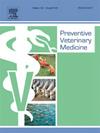Biocheck.UGent: A risk-based tool to assess the status of biosecurity in backyard poultry in low- and middle-income countries
IF 2.4
2区 农林科学
Q1 VETERINARY SCIENCES
引用次数: 0
Abstract
Backyard poultry farming is common in rural areas worldwide, especially in low- and middle-income countries, where approximately 80 % of rural households are involved. Effective biosecurity assessments are essential to prevent diseases and therefore, this study aimed to develop a risk-based weighted scoring system to evaluate biosecurity levels in backyard poultry households in low- and middle-income countries (LMICs), as well as to describe its use in Bangladesh. A questionnaire was drafted with input from backyard poultry experts, followed by weights were attributed to the answers to obtain a weighted and risk-based questionnaire where scores represent the level of biosecurity measures. A score of 0 indicates absence of biosecurity measures, while 100 implies optimal biosecurity. The questionnaire was pretested with 20 households in Savar, Dhaka. Subsequently, 384 households were randomly selected from six districts in Bangladesh, based on the poultry population and consistent backyard poultry rearing. The scoring system is freely available online at https://biocheckgent.com/en/. External biosecurity (50 questions) was assessed in the following subcategories: purchase of eggs or day-old chicks, purchase of laying hens, depopulation and transport of poultry and poultry products, feed and water supply, visitors and farm personnel, manure and carcass removal, infrastructure and biological vectors of the farm, location of the farm. Internal biosecurity (13 questions) was subdivided in disease management and cleaning and disinfection. The average biosecurity scores for the external and internal categories were 30.3 % and 32.4 %, respectively. The two highest mean external biosecurity scores were obtained for depopulation and transport of poultry and poultry products (mean= 56.0 %) and manure and carcass removal (mean = 37.5 %) while the lowest means score was obtained for the category visitors and farm workers (mean = 12.4 %). In the internal biosecurity category, cleaning and disinfection had the highest mean score (34.1 %). Besides backyard production, small-scale commercial broiler production was present in 7 % of the visited households and the biosecurity score in these households was on average higher compared to those without commercial farming. This study reveals sub-optimal levels of biosecurity among backyard poultry in Bangladesh, as evaluated through the Biocheck.UGent scoring tool which has shown to be valuable for addressing biosecurity challenges in backyard production in low- and middle-income countries. The observed biosecurity gaps expose the poultry system to considerable risks of introduction and spread of infectious diseases.
Biocheck。UGent:一个基于风险的工具,用于评估低收入和中等收入国家后院家禽的生物安全状况
后院家禽养殖在世界各地的农村地区很常见,特别是在低收入和中等收入国家,其中约80% %的农村家庭参与其中。有效的生物安全评估对于预防疾病至关重要,因此,本研究旨在开发一种基于风险的加权评分系统,以评估中低收入国家(LMICs)后院家禽家庭的生物安全水平,并描述其在孟加拉国的使用情况。根据后院家禽专家的意见起草了一份调查问卷,然后对答案赋予权重,以获得一份加权的基于风险的调查问卷,其中得分代表生物安全措施的水平。0分表示缺乏生物安全措施,而100分表示生物安全最佳。对达卡萨瓦尔的20个家庭进行了问卷预测。随后,根据家禽种群和一贯的后院家禽饲养情况,从孟加拉国6个区随机选择了384户家庭。该评分系统可在https://biocheckgent.com/en/上免费在线获得。外部生物安全(50个问题)按以下子类别进行评估:购买鸡蛋或日龄雏鸡、购买蛋鸡、家禽和家禽产品的减少和运输、饲料和供水、游客和农场人员、粪便和胴体清除、农场的基础设施和生物媒介、农场的位置。内部生物安全(13个问题)细分为疾病管理和清洁消毒。外部和内部类别的平均生物安全得分分别为30.3 %和32.4 %。禽类和禽类产品的减少种群和运输(平均值为56.0% %)以及粪便和胴体的清除(平均值为37.5% %)获得了最高的两个外部生物安全平均得分,而游客和农场工人类别的平均得分最低(平均值为12.4 %)。在内部生物安全类别中,清洁和消毒的平均得分最高(34.1% %)。除后院养殖外,7%( %)的受访家庭有小规模商品肉鸡养殖,这些家庭的生物安全得分平均高于没有商业养殖的家庭。本研究表明,通过生物检查评估,孟加拉国后院家禽的生物安全水平低于最佳水平。UGent评分工具已被证明对解决低收入和中等收入国家后院生产中的生物安全挑战很有价值。观察到的生物安全缺口使家禽系统面临传染病传入和传播的巨大风险。
本文章由计算机程序翻译,如有差异,请以英文原文为准。
求助全文
约1分钟内获得全文
求助全文
来源期刊

Preventive veterinary medicine
农林科学-兽医学
CiteScore
5.60
自引率
7.70%
发文量
184
审稿时长
3 months
期刊介绍:
Preventive Veterinary Medicine is one of the leading international resources for scientific reports on animal health programs and preventive veterinary medicine. The journal follows the guidelines for standardizing and strengthening the reporting of biomedical research which are available from the CONSORT, MOOSE, PRISMA, REFLECT, STARD, and STROBE statements. The journal focuses on:
Epidemiology of health events relevant to domestic and wild animals;
Economic impacts of epidemic and endemic animal and zoonotic diseases;
Latest methods and approaches in veterinary epidemiology;
Disease and infection control or eradication measures;
The "One Health" concept and the relationships between veterinary medicine, human health, animal-production systems, and the environment;
Development of new techniques in surveillance systems and diagnosis;
Evaluation and control of diseases in animal populations.
 求助内容:
求助内容: 应助结果提醒方式:
应助结果提醒方式:


